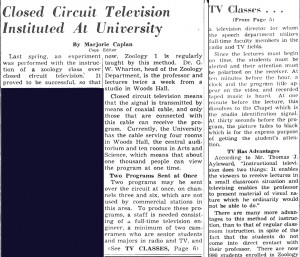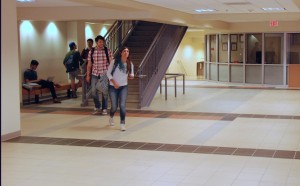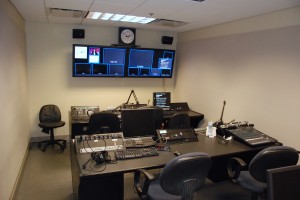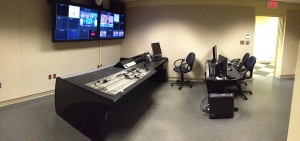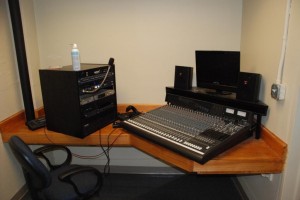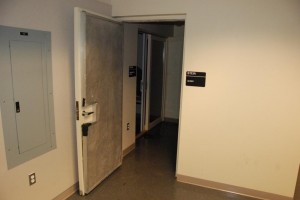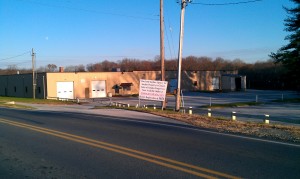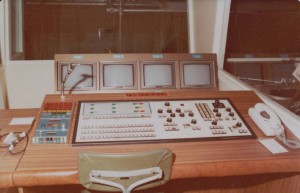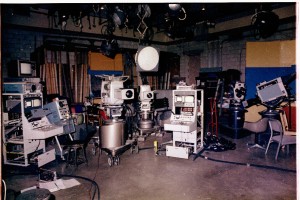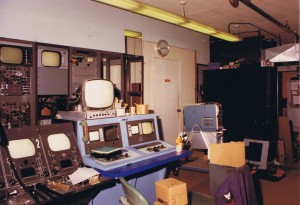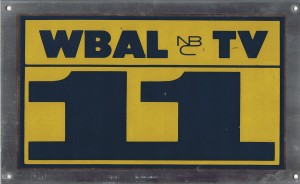The DIAMONDBACK is available on Microfilm at McKelden Library. The yearbook is available for electronic viewing through Hornbake Library, and can be accessed (and pages printed) at no charge. The tabs across the top of the home page identify documents pertaining to RTVF by published year.
Author Archives: admin
RTVF began as SPEECH
What would become RATV began sometime prior to 1959 at Woods Hall. Tele-courses were coming into vogue. The University of Maryland was offering introductory Zoology classes either in the traditional classroom setting or via TV. Parts of the campus were interconnected with cable (always referred to in those days as “coaxial cable” because the “coaxial” designation implied what would be known later as “broadband”).
These courses were produced live out of a studio at Woods Hall. The photo below was taken from the 1959 yearbook. The CCU equipment is very likely Sarkes Tarzian equipment. Sarkes Tarzian was a major player in the early days of television and CATV.
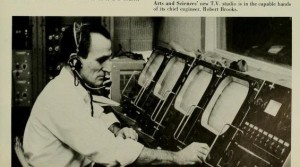 The Diamondback featured several articles about the teleteaching activites. Once such article describes the Zoology program.
The Diamondback featured several articles about the teleteaching activites. Once such article describes the Zoology program.
Tawes Today
I visited the Tawes building in late September of 2013. RTVF Alum Dave Bittner had stopped in prior to my visit and sent me some pictures. I had to see the facility with my own eyes, and I must say it is impressive. The Tawes building has been extensively renovated. For a person who was involved with every nook and cranny of the building, the first walk-through is surreal. You’re in Tawes, but you’re not. Hallways are re-directed, doors are missing (or added) stairs are changed. There is a central stairway to the ground floor from the lobby. The place is familiar and strange at the same time.
The half-stairway down to Tech Center is wider, and a wheelchair access elevator is installed as well. A plate-glass window once looked into Tech Center. It is gone now, and the stairway landing is quite different.
Control Room “B” and Studio “B” are to the left in the above picture. A very nice Journalism facility is housed in this area. The former Control Room “B” area has been converted to an office. The hallway from TV to the Theatre has been narrowed and the space gained shifted to Studio “B”. Edit bays are configured inside Studio “B”, and a bull-pen work area is in place along with a permanent studio set.
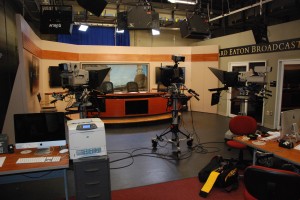
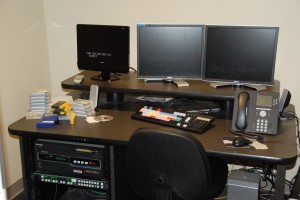 The Journalism control room is nicely outfitted with equipment of this century. Gone are the Conrac 14 inch tube-type monitors displayed behind the control room window!
The Journalism control room is nicely outfitted with equipment of this century. Gone are the Conrac 14 inch tube-type monitors displayed behind the control room window!
Tech Center is remarkable. Cable trays and conduit have replaced the old cable troughs, Modern equipment racks are installed. The rack wiring is top-notch. The cardboard air deflector installed in the old air conditioning ductwork is no more. (“The Bubba White Memorial Tomb” was printed on that cardboard ductwork for some reason that escapes me). A very nice shop is installed where the 3/4 inch editing bay once was. 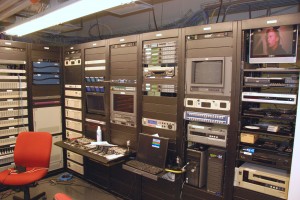
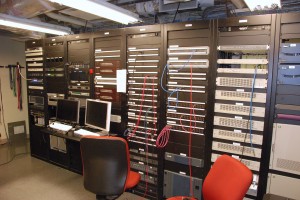
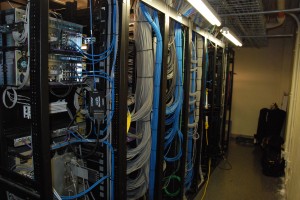
Studio “A” is used by UMTV. It now features a modern lighting board with modern lighting instruments. The scene dock has been removed to open up some additional space. The door to the former shop is now in use, because the hallway door to the former shop is gone. At one time, the rear door of Studio “A” opened up to a ramp to the loading dock. Load-in and load-out was painless. Today, a physical plant building is butted up against the loading dock, and the handy ramp is a thing of the past.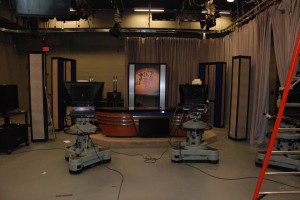

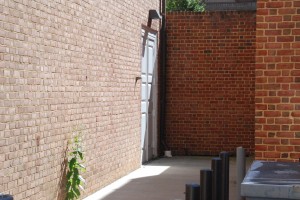
Control “A” is equipped with a multi-M/E Sony switcher, and a high quality multi-image display processor.
I was able to find only one tie to the past. The announce booth door in Control “A” still retains the acoustical treatment that was installed (presumably) when the original Tawes construction took place.The audio control room is located in the former announce booth, with the active announce booth separated by a sliding glass door.
My thanks to Al Perry, William Parker, and Sue Kopen Katcef for their hospitality during my impromptu visit.
Welcome to University of Maryland RTVF (v 1.1)
Featured
I started this site with the intention of documenting some of the miscellaneous technology I have “appreciated” over the years. My plans changed after posting some information about my experiences as Chief Engineer at the University of Maryland RTVF studios quite a few years ago. During my years there, I had puzzled over exactly how the department’s technical facilities had developed into the conditions that were in place in 1977. I set aside my original intentions for this site, and have been focusing on delving into the history of UM RTVF (RATV) both before and after my “tenure” there. History is made by those who write it. So as you read, please comment with corrections or additional information.
If you haven’t been here lately, you might enjoy it more if you start with the older posts first.
The 5532 IC and our leap into Audio Distribution Amps
In the days before routing switchers, audio sources needing to appear on more than one mixer had to be “split” through one of a couple of means. The absolutely cheapest and worst method was to simply wire them up in parallel. Short circuits, insertion of patch cords, and so on would hammer the audio to all destinations. The method in place in the early years of RTVF was an RCA “MI” part number passive resistive divider. These were packaged in nice small metal cylinders with solder terminals on the phenolic base. Several problems here. First, we had a mix of balanced and unbalanced signals. The resistive pad/ladder arrays in the dividers responded differently to high impedance, low impedance, balanced, and unbalanced sources/loads. Worse, the RCA BC-7 mixers used +8 dBm for standard output (so did the quad machines) other mixers used +4, and of course the industrial/pro-sumer gear was -10. We needed Audio Distribution Amplifiers.
Several engineering building-blocks were simply never available in the “donation market”. Waveform monitors and vector scopes were impossible to find “for free”. Following along behind the scopes were video and audio distribution amplifiers and patch panels. These items were expensive and virtually never showed up even at Maryland Surplus Property.
During the late 70s / early 80s, experts such as Walter Jung and others published I.C. “cookbooks”. These were engineering publications that offered in-depth analysis of commercially developed integrated circuits and contained generic schematic diagrams of suggested applications. National Semiconductor, Motorola, and Signetics all published excellent product specification manuals. The 5532 chip was cheap, had very good performance, and could drive a balanced audio load to very high levels at low distortion, so we decided to make our own audio distribution amplifiers.
As in the past, we submitted a work order to the excellent folks at the Physics Department. We provided a rough layout and our schematic, and the Physics department manufactured a blank circuit board per our specs. We specified gold plated card-edge contacts and edge connectors to keep things “quiet” and used an off-the-shelf Vector brand enclosure for our boards. Each board had a master gain, and trim gains for each output.
As in the past, the interns stuffed the circuit boards with the parts, soldered them in, and participated in testing their product. I made my one request: where possible, install the resistors with the color code facing the same direction, mount components with alpha characters such that you can read them with the board oriented “up”. The above picture is a board I kept as a souvenir. Note that board was laid out as a 1 by 4. Despite the low cost of the parts, we stuffed this one for three outputs. I can’t recall why.
Duca-Richardson Production Switcher Redux
I told a story about Jim Duca and his flying Fluke in a previous post. Recalling the pleasant evening Bob and I spent with Jim as he tweaked our new switcher made me wonder about the history of the Duca-Richardson Corporation. We knew that we had purchased an early model. Could we have purchased Serial Number 1? The answer is “no”. But close. I tracked Jim down and sent him an email asking him if he could tell me a little about his recollection (if any) of our University of Maryland purchase after all these years. Jim is a very gracious person, and penned a story about how he came to start the Duca-Richardson Corporation. He has allowed me to post it here. The story speaks volumes about American ingenuity, and the value/effect of small business in our economy. Here are Jim’s comments about a very interesting time in his life, and about a product that helped move RTVF closer to our desire to be in line with the industry of the times.
Jim Duca:
“For a long time I had wanted to have my own company to build broadcast products that I felt offered more capabilities and at a much more favorable price than was currently available. I had two of the ingredients needed to do so, an empty basement and a willing partner to take care of the business end of the venture. That was Bob Richardson, the “R” in DRC. So with blind enthusiasm I began to design and develop broadcast switching equipment. Our first customer was a local television station who saw our first prototype product in our small booth at NAB. That was the good news …the bad news was that he wanted the largest switcher in our catalog, one that we had not yet envisioned would be the first out of the pipeline. None the less, it was time to move out of the basement and into a facility in Wheat Ridge, Colorado, large enough to accomplish our mission. That brings us to the University of Maryland’s order, it must have been only about serial number 5 or 6 as I recall. Now I had a few engineers to help design in the features specific to each customer and it seemed that each order was still unique. What I didn’t have was a Service Department to take care of the installations, so I did that part myself. I would schedule the installation to occur on a weekend so could be “in and out” and be back in the office on Monday. You do these things when you get started in business, besides we were grateful for our customers and with a small staff it didn’t seem unusual to be involved in all aspects of the operation. Besides it gave us good feedback on product reliability. We fortunately continued to be successful and after about a year, we were approached by the Ampex Corp. to supply switching products that they in turn would market. Before that even got started they wanted us to label our products with the Ampex name, but before even that happened they decided to buy the company outright, so that was the last of DRC. The University of Maryland was unique in the fact they had one of the few switchers labeled “DRC.” “
THANKS Jim, for a most interesting contribution to the tech history of RTVF.
Recycling before we went “green”.
Funding for RTVF equipment was always scarce. Even if an annual budget included funds earmarked for equipment purchases, one never knew if the Maryland Legislature would engage in some kind of budget tom-foolery and interfere with our plans. We wanted to expand the department’s equipment resources, and had no sure source of money. But we did have a secret weapon…
Gene Weiss
Gene was second to none when it came to gathering up still-decent “stuff” from far and wide. He kept his students well stocked in short-ends of film gleaned from his contacts in the local media. Somehow, he got the entire IATSE-built Soviet Arms Limitation Talks TV set delivered to the TV studios. Production houses and studios all over DC knew to contact him with “give-aways”, and all this spoke to the respect the RTVF department had accrued within the media community.
But the ace up Gene’s sleeve was the Maryland Surplus Property Disposal Unit in Jessup.
This facility received both State and Federal surplus property and housed it for distribution both to authorized users (Gene among them) as well as direct sale to the public. Gene would hear about a load of (say) Crown model 800 reel-to-reel machines on its way to Jessup, and he would swoop in and snatch them up. In this way, the RTVF department could go from one radio studio with a couple of reel-to-reel machines to a facilty with a quarter-inch editing room consisting of 8 machines, three radio studios each with a pair of quarter inch machines, 2 TV control rooms with a reel-to reel, and a shop-full of less desirable machines from which to pick spare parts.
There is an endless list of projectors, film cameras, amplifiers, monitors, recorders, test equipment, and so on that were the underpinnings of a very vibrant RTVF department. A truck known to all TV interns of a certain period as “The “Blue Bomber” was yet another Jessup procurement. Bob Swanner. drove the thing back from Jessup (sort of). The gas tank had plenty of water in it, because at some time during its storage, the gas cap had been removed. We simply coasted to the side of the road when it died, took off the cover on the carb, splashed the contents (water) out of the bowl, and continued on our way. When Bob made an engine-sputtering hard left turn into Campus Drive, the entire exhaust system became disconnected and slid all the way across University Boulevard. (You had to see this with your own eyes to appreciate it.) And does anyone remember that the State of Maryland had a film censor board? When the board ended it’s oversight of films exhibited in Maryland, Gene managed to snap up the two Simplex 35mm projectors that had been in the screening facility. He then could screen 35mm prints for his students.
There is absolutely no way that the department could have grown to its eventual size without the continuous efforts of Gene and others to obtain useful items at low or no cost.
Richmond-Hill Switcher
The first production switcher I encountered at RTVF was a Richmond-Hill switcher that was installed in Control Room “A”. The control panel had 16 video sources plus M/E re-entry. However, back in Tech Center, the frame only had circuit boards enough to support 4 video inputs. I could only assume that this was a reflection of the budget limitations at the time of the switcher’s purchase. Here is a photo of a similar switcher. I was able to find only one photo on the web, and it is from a page of history from a TV station in Australia.
An unusual feature of this switcher involved setting up for a key. Several switchers had “push-to-preview” key clip knobs, but this one switched the M/E monitor to “key” when you touched the key clip knob. Very cool! The unit had been modified with a toggle switch to turn “off” the color burst on the black/background generator. 3/4 inch machines of the day would activate their internal color processing circuitry based upon whether the video input had “burst” in the sync interval. Fading a monochrome camera to switcher black (with the burst turned on) would cause an obvious glitch upon playback. This is demonstrated in the RTVF 440 clip when switching to the black and white film chain from the color studio cameras.
As we got VTRs up and running and added cameras to the studio, we needed to add input capability to the switcher. Each source required a video input/proc card, and two video matrix cards. We involved the Physics Department support team in laying out printed circuit artwork, and manufactured our own boards. We taught RTVF interns to properly mount all the on-board components to the pre-drilled boards. I was rather particular, and wanted all the resistor color code bands to point the same way on the boards. We taught the soldering skills needed to ensure quality connections. That’s the extent of the engineering involvement in making the boards….the interns did all the assembly, and when I found the very few that did not work, the interns went over their work and corrected the problems. Bob McCleary found the address of my component supplier to be amusing, for some reason. I used Digi-Key, and they were located in Thief River Falls, MN.
This was an early indicator of how things would be. The RTVF equipment budget was virtually nil at that time. If engineering needed something, we had to either build it, or find it at the Jessup Surplus Depot.
UPDATE
A telephone conversation with Gene Weiss revealed the source of the Richmond Hill switcher. The switcher was part of a horse-trade between Gene and a local production house. Gene did not recall the name of the facility, so we will never know why it was purchased with only 4 inputs. But the fact that it was not originally purchased by RTVF clears up one of the questions on my list.
From TK-60s to PC-60s
Once we had cameras functioning in two studios, we turned our attention to a couple of Norelco PC-60s locked away in a storage room. There they sat, resting upon a couple of (leaky) TVP pneumatic pedestals. At that time, the shop was a small room next door to Control “B”. The students must have been gone for the summer, because we took over most of studio “A” with a vow to get them working and on-line. As part of writing this post, I located Greg McMurry. He was one of the engineers who preceded me. He told me that he had procured these cameras in hopes of “going color” after a false-start involving a couple of RCA TK-42s.
The cameras had been in the storage room for so long with irises open that an image of the storage room door was permanently captured in the pickup tubes of one of the cameras. This set me off on a “Plumbicon collection campaign” that taught me how generous some broadcasters are when it comes to helping a fledgling educational facility. 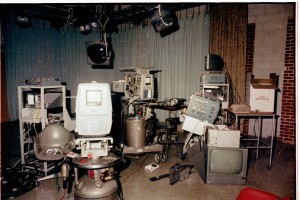
The above photos were taken as Bob Swanner dug elbow-deep into these cameras with some serious dedication to getting them operational. I believe the blue chassis are after-market encoders, and that the original Norelco encoders were not part of these camera chains. Besides the Conrac RHA monitor sitting on the floor, there is a Ball Brothers (Miratel) monitor in the background. The Mason jar manufacturer was also into video monitors and other equipment. The cameras likely put out video when first fired up, but it is for certain that they were in need of tubes, serious tweaking, all new registration pots, and about 2 gallons of contact cleaner.
In speaking of the generosity of other broadcast engineers, our search for “gently used” (this means pin-holes smaller than .22 cal bullet holes) Plumbicon tubes took us to WJET-TV in Erie, Pennsylvania. There, in a quonset hut on the outskirts of town…and directly under the transmitting tower, we were given at least one additional PC-60 camera chain, manuals, boxes of Plumbicons, and genuine “fellow broadcaster hospitality” that you remember for the rest of your life.
If you want to see PC-60s in overwhelming depth and detail, visit this amazing site: Eyes of a Generation.
The TK-60
The first cameras used at RTVF were RCA TK-60 models. They employed a 4 1/2 inch Image Orthicon pick-up tube, and had 4 lenses mounted on a turret. One camera had a Varitol zoom lens. These cameras were built like tanks, and were introduced in 1962. The Image Orthicon tubes had their own “look” that included halos around bright objects, but when properly aligned, they could make nice looking black and white video. The photo below was taken “early-Bob Swanner.” but “post-flood”. Bob was instrumental in making physical upgrades to Tech Center, and one of these upgrades was the installation of a suspended ceiling…missing in this shot. But the photo also shows a 4 inch drain pipe installed in the ceiling. That puts the photo post-chiller-condenser rupture. (A future post will deal with Tech Center’s affinity for water).
Even though the TK-60s were monochrome and turret lens equipped, they did give the students the feel of trucking and dollying a professional-sized camera and pedestal. By the time we revived a full complement of cameras, we had them sitting on cam-heads which permitted students to experiment with tilt/pan drags and locks.
The TK-60s were a very important camera in the history of RCA broadcast cameras, and incorporated some RCA “advancements” such as Nuvistor tubes in the preamp, and an image orbiter to keep the Image Orthicon from burning-in. They were used world-wide.
There were quite a few TK 60 cameras locked away in the storage room. Apparently, WBAL in Baltimore had made some available to the department. Here’s a station-made camera logo plate (yes…TV stations once had people who did things such as cut stainless steel and build contraptions for various purposes on an as-needed basis.)
Prior to the filming of the Barry Levinson film Diner, we were contacted by the production company and asked if they could rent the WBAL cameras for a scene that takes place in the WBAL studio. The rental never took place, but they did use the actual control room at WBAL.
On a non-RTVF note, I have a personal fascination with the use of TK-60s for “Electronovision”…a process by which live events were recorded direct to film using “high definition” TK-60 cameras. The French developed a monochrome video standard having 819 lines. I believe it was 25 frames per second. I have seen RCA equipment configured for 819 lines, and have to assume that Electronovision used cameras modified to run at 819/24 even though the spec sheet describes only 525/625 operation. (Have any Electronovision facts? Let me know). The TAMI show was recently released on DVD. If you want to see an important 60s Rock-and-Roll FILM shot with TK-60s, check out the link below.
And if you are interested in the full specifications for a TK-60 camera chain, here is the 1964 RCA Broadcast Catalog layout. TK60 Technical Specifications
Oh, by the way. Check the TK-60 price on the last sheet of the tech specs. You could have purchased 5 Corvettes in 1964 for the price of one TK-60.
